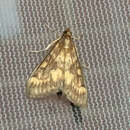Brief Summary
(
Inglês
)
fornecido por EOL authors
The European corn borer (Ostrinia nubilalis) has a wide host range but is primarily a pest of its preferred host, maize. It also feeds on Sorghum, cotton, potato and capsicum crops. Ostrinia nubilalis is one of the most widely studied crop pests in the world, and has an extensive literature associated with it. Native to Europe, it was first discovered in North America in Massachusetts 1917, and has since spread into Canada and across the US as far as the Rocky Mountains. It also occurs in North Africa. A sister species, Ostrinia furnacalis (the Asian corn borer) attacks maize in China and other parts of Asia and is easily confused with O. nubilalis. Ostrinia nubilalis has a complex population structure, with three recognized subspecies. Within these subspecies there are several known strains which produce different pheromones, and ecotypes that differ in number of generations produced annually, ranging from 1-6 generations/year.
Caterpillars are about 1.5mm long at first instar and reach a final length of 2.5mm. They are pink or brown and burrow into corn ears and stalks, damaging kernel production and causing stalks to collapse. Caterpillars generally remain concealed inside the plant, so are difficult to initially detect and access. Fully grown larva overwinter inside tunnels in corn stalks, or in wild plants.
Although chemical pesticides are applied to control O. nubilalis on capsicum and potatoes, chemical control is considered less effective for this pest on maize, because of the expense, the effect of the pesticides on beneficial species that help with control, and the difficulty of accessing the larvae inside the plant. Alternative control methods include release of commercially available parasitic Trichogramma wasps. The bacteria Bacillus thuringiensis subsp. kurstaki (Bt) can be successfully applied to target first stage larvae, and hybrid maize strains have been engineered to produce Bt toxins. Bt-corn however, has critics that worry about the effect of Bt on non-target species and also on producing Bt-tolerant strains of O. nubilalis. Maize hybrids created for tolerance to boring damage are also available and have helped minimize losses. Pheromonal control (using synthesized female sex pheromones to attract and trap males) proves difficult because the different moth strains are sensitive to different combinations of pheromone chemicals, but pheromone traps can be helpful in monitoring populations and timing of stages in the field.
(CABI, 2011; Capinera 2000)

